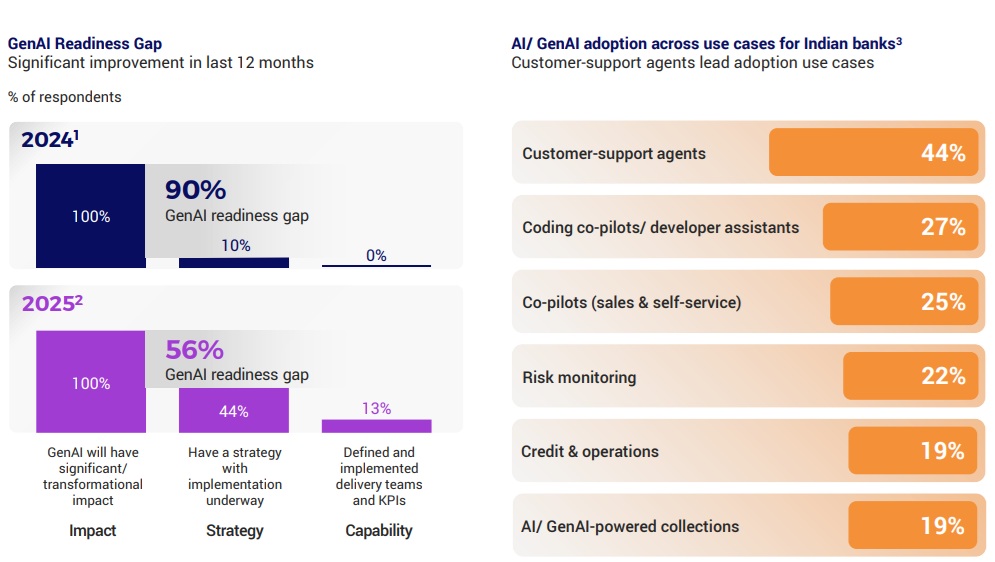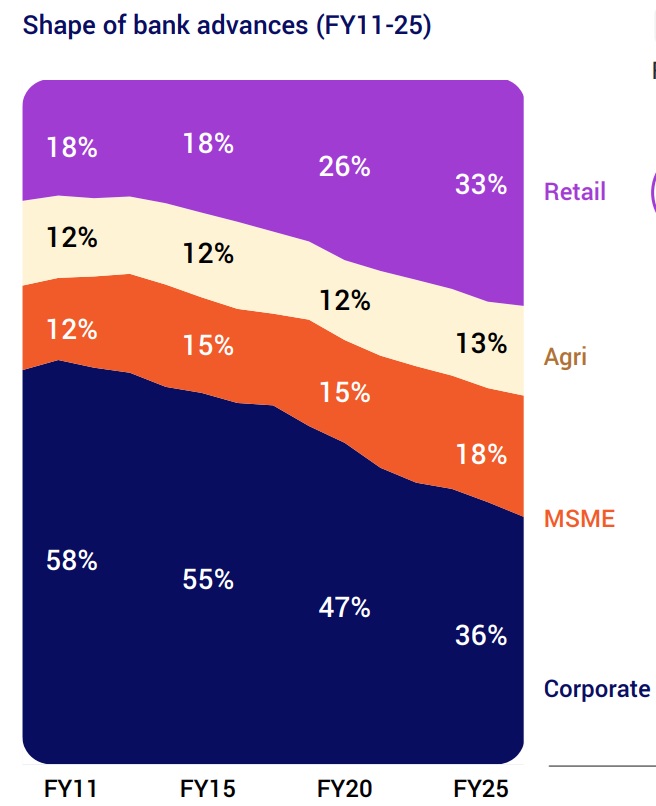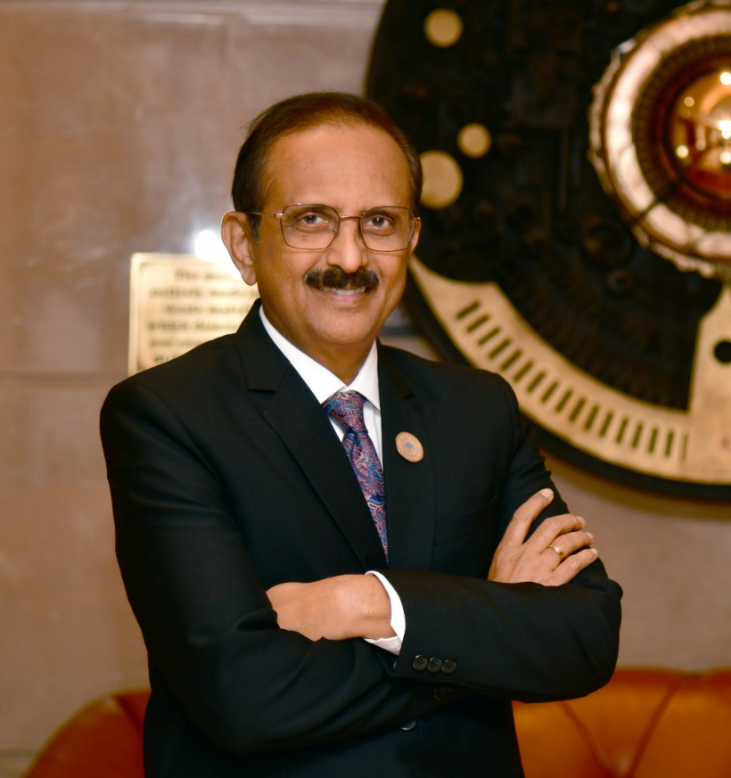BCG-FICCI-IBA Report: Indian Banking Sector Must Grow 3-3.5 P.P. To Realize Viksit Bharat Mission


FinTech BizNews Service
MUMBAI, August 25, 2025: Boston Consulting Group (BCG) in association with FICCI and Indian Banks’ Association has released a report titled “Charting New Frontiers”. The report emphasizes that India is at a critical inflection point in its development trajectory, where the next two decades could transform today’s momentum into sustained global leadership. Realizing its ambitious ‘Viksit Bharat Mission’ will hinge on the evolution of a robust, innovative, and resilient banking and financial sector, capable of supporting India’s aspirations for sustainable, inclusive growth.

Mr. Ruchin Goyal, Managing Director and Senior Partner at BCG
For India to meet its Viksit Bharat targets, banking assets need to grow at 3.0–3.5 percentage points faster than its nominal GDP. Currently, economies and their banking sector operate in a complex, multipolar world with volatile trade flows, shifting supply chains and geopolitical risks.
The combined disruption of AI/ GenAI and shifting consumer expectations is unfolding at a scale never seen in the last few decades.
The Indian banking industry is poised to reach for leadership – it is profitable, well capitalized and
highly valued. The report highlights that it will need to seize this opportunity by charting new
frontiers:

Mr C S Setty, Chairman of Indian Banks’ Association,
1) Unlocking credit growth
The bank lending mix has changed significantly over the last 14 years, with share
of corporate advances dropping from 58% to 36%.
Corporate funding has moved away from banks, towards capital markets and
alternate funding avenues (e.g., Private credit). Within bank funding, the mix is
shifting towards short-term working capital compared to long term capex.
NTC retail lending is at an all-time low – at this rate, universal credit penetration
will take more than a decade. Historical performance shows that well-under written
NTC loans can perform at par with ETC customers, indicating room to expand
responsibly.
Financial inclusion efforts on MSME lending shows promise. Formalization efforts
(e.g., Udyam, GST), proliferation of digital payments (UPI, QR codes) and
enhanced coverage through guaranteed schemes have driven a high share of
NTC lending among MSMEs.
Lenders need to embrace the full power of data, including alternate data, and AI
capabilities to manage and measure new, emerging risks (e.g., fraud, climate).
For India to achieve its long-term Viksit Bharat ambitions, the corporate sector will play a key
role. Banks must re-engage in corporate credit, especially in infrastructure, manufacturing, and
renewables that will define the nation’s future. At the same time, resilience has to be embedded
as a core business priority, from managing climate risk to strengthening cyber defenses and
operational continuity. The ability of our banking system to fund growth while safeguarding
stability will be central to India’s journey toward a Viksit Bharat says Jyoti Vyij, Director
General, FICCI.
2) Driving productivity
The Indian banking industry's opex to assets ratio has risen by 26 bps over the
past 14 years, a trend that is opposite to the rest of the world.
Despite a decade of digitization, real productivity gains have been limited, with
only about 1% annual improvement over the past 15 years after adjusting for
inflation and capacity growth.
AI/ GenAI promises transformational capabilities. With mature deployment, 35-
40% of current low value activities can be automated.
AI/ GenAI programs have to be business led, enabled by engineering teams.
3) Digital maturity
Non-bank (especially UPI) apps are perceived to be more user friendly and
intuitive. However, customers still prefer to use their banks for loans and
investments.
The challenge with banks is that their digital journeys involve a lot of friction and
adoption issues. AI/ GenAI can enable seamless journeys and personalization
with conversational and agentic journeys.
DPI 2.0 aims to achieve more complex use cases — consent management and
lending. It will need to be designed in a manner that will enable as frictionless
transactions as with DPI 1.0.
ULI has the potential to create a UPI-like explosion in lending. Regulators,
Government and Financial Services sector, all will need to work together to build
access and digital registries to enable this (e.g., digital land records).
Mr C S Setty, Chairman of Indian Banks’ Association, said, “India’s Digital Public
Infrastructure has revolutionized access through Aadhaar, UPI, and Jan Dhan, and the next
frontier lies in DPI 2.0 platforms like Account Aggregator and Unified Lending Interface (ULI). To
unlock their full potential, banks must go beyond transactions and deliver seamless, end-to-end
digital experiences to the customers that combine trust, simplicity, and omni-channel support
leveraging GenAI as well. By doing so, banks can deepen inclusion, strengthen customer
relationships, and create a truly world-class digital banking ecosystem.”
4) Embedding resilience:
Banks need to move beyond credit risk and manage emerging macro risks, e.g.,
climate, cyber and geo-political risks.
Shared industry utilities such as NPCI, credit bureaus have done well to raise the
standards of all participants in the financial sector.
The Banking sector will benefit from creating new utilities for emerging risks like
climate finance and transaction monitoring.
Mr. Ruchin Goyal, Managing Director and Senior Partner at BCG, and a co-author of the
report, said, ‘‘India’s banks have delivered strong performance in recent years, but to truly power
the Viksit Bharat mission they must grow 3–3.5 percentage points faster than nominal GDP. The
sector has a unique opportunity to unlock the next wave of growth by leveraging alternate data
and DPI 2.0 to bring millions of new-to-credit households and MSMEs into the formal lending
system. At the same time, banks must move beyond incremental productivity gains and use
GenAI for a step-change—rewiring core processes, redeploying capacity to higher-value
activities, and setting new global benchmarks for efficiency. If they act decisively, banks won’t just
support the mission—they’ll become the very engine of Viksit Bharat.”
India’s banking sector is well-positioned but must accelerate transformation across growth,
productivity, digital maturity, and resilience to meet its Viksit Bharat ambitions. Simultaneously,
there is a need to expand into untapped credit segments, unlock productivity with AI/ GenAI,
deliver world class digital experiences, and embed a deep risk culture. Only then can banks
become the driving force behind India’s economic rise.
A joint push by industry participants, government, and regulators will be critical to this journey.
Key actions:
Banks to leverage alternate data for underwriting and build capabilities to manage
emerging risks.
Regulators to provide greater flexibility to banks in providing corporate credit and promote
world class utilities for Climate, Cyber and Fraud risks like NPCI, Credit Bureau.
Government to fast-track implementation of DPI 2.0 and standardize KYC norms across
financial products.